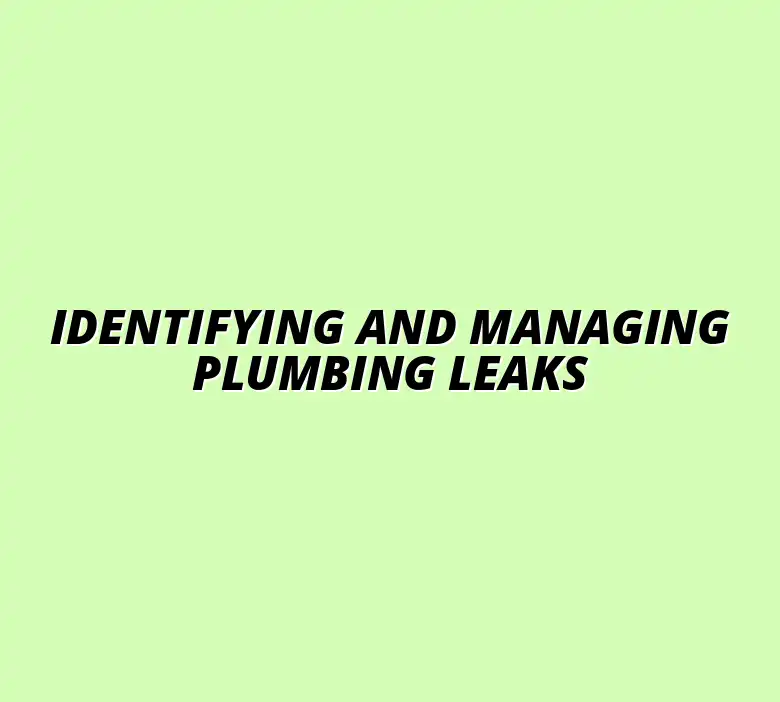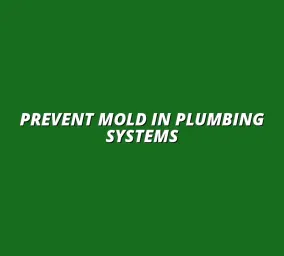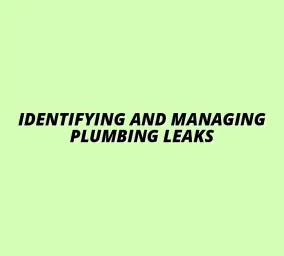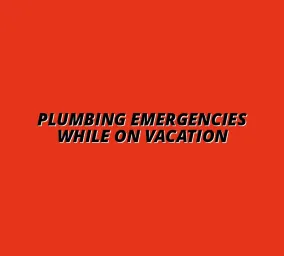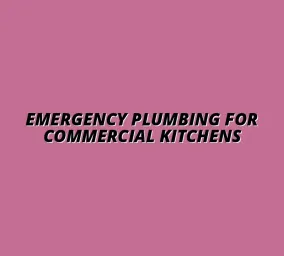Identifying and Managing Plumbing Leaks
Understanding Hidden Plumbing Leaks and Their Impact
Hidden plumbing leaks can be a homeowner's worst nightmare. They often occur without any visible signs, meaning they can cause significant damage before you even realize what's happening. Understanding these leaks and their impact is crucial, as they can lead to increased water bills, structural damage, and mold growth, affecting both your home and health.
When we talk about hidden plumbing leaks, we're referring to leaks that aren't easily visible or detectable. These can occur in walls, under floors, or even within the plumbing system itself. Addressing them promptly is essential for maintaining a safe and healthy living environment. For example, a seemingly minor leak in your kitchen plumbing can escalate into a major emergency if left unaddressed. Learn more about managing kitchen plumbing emergencies to avoid costly repairs.
Defining Hidden Plumbing Leaks: Why They Matter
Hidden plumbing leaks can silently wreak havoc in your home. They not only waste water — which is a precious resource — but they can also lead to costly repairs down the line. Knowing what causes these leaks can help you take preventive measures and act quickly if you suspect one.
Some of the common causes of hidden plumbing leaks include:
- Corroded pipes
- Improper installation
- High water pressure
- Shifting ground
- Frozen pipes that thaw
The Importance of Early Detection
Detecting a leak early can save you a lot of hassle and expense. The sooner you find and fix a leak, the less damage will occur. It can also help you avoid health issues related to mold and mildew, which thrive in damp environments. Knowing the warning signs is key; if you notice any, it's vital to act quickly. Find out more about urgent plumbing emergency warning signs and how to react.
Early detection can lead to:
- Reduced repair costs
- Lower water bills
- Improved air quality
Common Causes of Hidden Plumbing Leaks
Identifying the causes of hidden leaks can empower you to take preventive actions. Additionally, knowing these causes can help in recognizing the signs of a leak early. Some factors that contribute to hidden plumbing leaks include:
- Old or deteriorating pipes
- Improper sealing around fixtures
- Wear and tear from age and use
Addressing these issues can prevent leaks before they become a significant problem! Regular maintenance is crucial, and a simple check for leaks around your water heater can prevent costly repairs later. See our tips on how to prevent water heater leaks easily.
Recognizing Signs of a Hidden Leak
Being aware of the signs of a hidden leak can make a world of difference. Leaks can go unnoticed for extended periods, causing extensive damage. Here are some signs that you should watch for:
- Unusually high water bills
- Water stains on walls or ceilings
- Mold or mildew growth
Unusual Increases in Water Bills
If you notice a sudden spike in your water bill without a change in usage, it could be a telltale sign of a hidden leak. This unexpected increase can indicate that water is being wasted somewhere in your plumbing system. Keep an eye on your water bill periodically; it can serve as an excellent first indicator of leaks.
Be sure to compare your monthly water usage with:
- The average usage for your household size
- Seasonal changes (like summer watering)
Water Stains and Mold Growth Indicators
Water stains on your ceilings, walls, or floors can indicate a leak. If you see any discoloration, pay close attention. Mold growth can also be a significant red flag, as it thrives in damp conditions, often a result of hidden leaks. A quick check for leaks in your bathroom is a simple preventative measure. Discover how to check for hidden bathroom leaks easily.
Look out for:
- Brown or yellow stains
- Peeling or bubbling paint
- Visible mold patches
Unexplained Dampness in Walls and Floors
Damp spots in areas like your basement, crawl space, or around plumbing fixtures could be signs of leaks. If you touch a wall or floor and it feels wet, there may be an issue. It’s essential to investigate these damp areas right away!
Sound Clues: Dripping and Bubbling Noises
Sometimes, you can hear a leak before you see one! Listen for unusual sounds like dripping or bubbling, especially when no faucets are in use. If you hear water running, it might indicate a leak deep within your plumbing system. Even a small leak from a faucet can add up to significant water waste and potential damage. Learn how to stop a faucet leak quickly.
Pay attention to:
- Pinging or hissing sounds
- Continuous dripping noises
Assessing Your Plumbing System
Regularly assessing your plumbing system helps you stay ahead of potential leaks. By knowing where to look and what to check, you can identify issues before they escalate. Here are key areas to focus on:
- Under sinks and around fixtures
- Basements and crawl spaces
- Behind walls, especially in bathrooms
Key Areas to Inspect for Leaks
It's vital to inspect certain areas regularly. Common spots where leaks can develop include:
- Water heaters
- Toilets and their connections
- Pipes in attics and basements
Take the time to check these areas, as they are critical for maintaining a leak-free home. Regular maintenance is your best defense against unexpected plumbing emergencies. Here's how to maintain your plumbing system easily.
Using Water Meters to Identify Leaks
Water meters can be a handy tool for detecting leaks in your home. By monitoring your meter usage, you can identify inconsistencies that may point to a leak. Here’s how to check:
- Turn off all water fixtures in your home.
- Check your water meter reading.
- Wait for a few hours and check the meter again.
If the reading has changed, you might have a leak somewhere in your plumbing system!
Emergency Response: What to Do if You Suspect a Leak
If you suspect a hidden leak, it's crucial to act quickly to minimize damage. Here are some immediate actions you can take to address the situation:
- Identify and shut off the water supply.
- Contain any visible leaks with towels or buckets.
- Contact a professional plumber if needed. If you need a plumber in a hurry, finding a reliable emergency service is key. Consider finding a plumber in Birmingham or your local area.
Immediate Actions to Minimize Damage
Taking swift action can help reduce damage to your home. The first step is to stop the flow of water if possible. This can prevent further damage to your property and reduce the risk of mold growth.
Other immediate actions include:
- Moving furniture away from damp areas
- Using fans or dehumidifiers to dry out the area
Shutting Off Water Supply: Step-by-Step Guide
Here’s a simple guide to shutting off your water supply:
- Locate your main water shut-off valve. Usually, it’s near the water meter.
- Turn the valve clockwise to shut off water flow.
- Open a faucet to relieve any pressure before making repairs.
This step is essential in preventing further leaks and damage to your home.
Documenting the Leak for Insurance Purposes
If your home sustains damage from a leak, documenting the situation is vital for insurance claims. Take photos of any damage, keep records of repairs, and note any expenses. This documentation will help you in case you need to file a claim later.
Be sure to gather the following:
- Photos of the leak and any damage
- Receipts from repairs or temporary fixes
- Your water bills before and after the leak
Effective Methods for Handling Hidden Plumbing Leaks
When it comes to managing hidden plumbing leaks, knowing when to seek help is crucial. Engaging professional assistance can save you time and potentially a lot of money in damage repair costs. It's important to understand the right instances that call for a plumber's expertise, ensuring your home remains safe and dry.
Engaging Professional Help: When to Call a Plumber
There are certain situations where calling a plumber is not just recommended, but necessary. If you notice severe water damage, persistent dampness, or hear unusual sounds, it’s time to pick up the phone. Professionals have the skills to correctly diagnose the problem and provide efficient solutions.
- Severe water stains on walls or ceilings
- Significant increases in water bills without usage changes
- Persistent mold or mildew growth
Finding the Right Plumbing Service for Emergency Situations
Choosing the right plumber can make all the difference. Look for reputable local plumbers who have good reviews and offer emergency services. This way, you can ensure timely and effective solutions when you need them the most.
Here are some tips to find the right plumbing service:
- Check online reviews and ratings
- Ask for recommendations from friends or family
- Ensure they provide 24/7 emergency services
Understanding Cost Implications of Leak Repair
Understanding the costs involved with plumbing repairs can help you budget accordingly. Depending on the severity and location of the leak, prices can vary significantly. Having an estimate before work begins will help you avoid any financial surprises.
Common factors that affect the cost include:
- Severity of the leak
- Accessibility of plumbing fixtures
- Time taken for repairs
DIY Solutions for Minor Plumbing Leaks
For small leaks, there are a few immediate fixes you can try. Tackling minor plumbing issues yourself can save you time and money. However, make sure you know when it's time to call in the experts.
Temporary Fixes You Can Implement Immediately
Here are some quick fixes you can try while waiting for a professional:
- Use duct tape to seal small pipe leaks temporarily
- Apply plumber's putty for leaks in joints
- Turn off water supply to the affected area until repairs are made
Tools and Materials You May Need
Having the right tools can make any DIY repair easier. Before you start fixing minor leaks, gather these essential items:
- Duct tape
- Plumber's putty
- Pipe wrenches
- Adjustable pliers
Preventative Measures to Avoid Future Plumbing Leaks
Taking steps to prevent plumbing leaks can save you a lot of hassle in the future. Regular maintenance and proactive measures will keep your plumbing system in good shape. Here are some effective methods to consider:
Regular Inspections and Maintenance Practices
Conducting routine inspections can help you catch issues before they turn into major problems. Here are some tips for effective maintenance:
- Check for visible leaks in basements and under sinks
- Inspect appliances that use water, like dishwashers and washing machines
- Flush your water heater annually to prevent sediment buildup
Installing Leak Detection Technology in Your Home
Consider investing in leak detection devices. These tools can alert you to leaks, helping you take action before significant damage occurs. Some advanced systems even send notifications to your smartphone!
- Smart water sensors
- Leak detection alarms
- Wireless monitoring systems
Frequently Asked Questions about Plumbing Leaks
Many homeowners have questions when it comes to plumbing leaks. Addressing these common concerns can help you feel more prepared in the event of an issue. Let’s explore some frequently asked questions.
How do I know if my plumbing leak is serious?
A serious leak often comes with noticeable signs like water stains, mold growth, or unusual sounds in your pipes. If you see any of these signs, it’s best to call a plumber for an inspection.
What are the long-term effects of ignoring a hidden leak?
Ignoring a hidden leak can lead to significant damage, including mold growth and structural harm to your home. It can also cause higher utility bills, which can strain your budget.
Can I fix plumbing leaks without professional help?
For minor leaks, DIY solutions can be effective. However, if the leak is substantial or ongoing, it’s wise to consult a professional to ensure a proper fix.
Final Thoughts on Managing Plumbing Emergencies
Managing plumbing emergencies can feel overwhelming, but being informed helps. Knowing how to act quickly and effectively can minimize damage and costs. Remembering these key points will guide you through the process!
Summarizing Key Points for Quick Reference
Here’s a quick recap of what you should do if you suspect a plumbing leak:
- Recognize the signs of a leak.
- Engage professional help when necessary.
- Implement DIY fixes for minor leaks.
- Perform regular inspections to prevent future issues.
Encouraging Proactive Plumbing Care for Homeowners
Investing time in proper plumbing care can save you a lot of trouble in the future. Stay proactive to keep your home safe and dry! With the right knowledge and resources, you're well on your way to managing plumbing emergencies effectively. Remember, preventative maintenance can save you money and headaches in the long run. For more tips on maintaining your plumbing system, check out our guide on maintaining your plumbing system easily.

